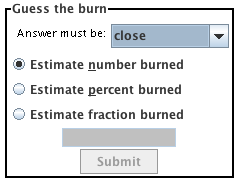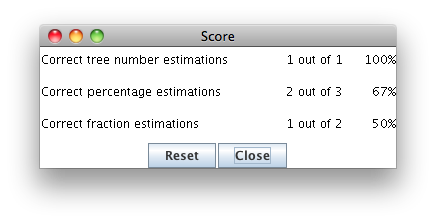What is Fire Assessment?
The purpose of this applet is for the user to practice estimation by guessing at how many trees, what percent of trees, or what fraction of the trees are burned down in the forest with each simulation. Four different sized grids are provided to practice estimating with small and large quantities. The user may also choose the probability of burn. Note that the probability of the burn does not predict exactly how many trees will burn, although there is a relationship.
Estimation is a useful tool to get a general idea about a quantity or a size when an exact answer is unnecessary. Estimation is also important for doing a long calculation with a lot of potential for careless errors - estimating the answer can confirm or counter the calculated answer. Especially in higher-level math, making an error early in a calculation will often cause the final answer to be off by an order of magnitude (x10) or more!
How Do I Use This Activity?
This activity allows the user to practice estimation skills by estimating the number of trees and the percentage of trees burned in a forest fire. This activity can be used to practice estimation with both large and small numbers since there are 4 settings for the forest: tiny, small, medium, and large.
Controls and Output
Clicking on any of the trees in the forest will begin the fire simulation. The user will then be able to watch the fire spread through the forest, based on the parameters selected. The user may adjust these parameters in the boxes to the left of the forest.
The
Probability box is located at the top left of the activity and allows the student to select the
probability that an individual tree will burn when the fire reaches it. At each timestep, a
tree on fire has a specified probability of spreading the fire to one of its immediate
neighbors: left, up, right, and down.

Beneath this, the Control the burn box contains settings that allow the user to customize the burn.
- The Forest size drop down menu allows the user to select how many trees will be in the forest. The tiny forest is 10x10, the small forest is 15x15, the medium forest is 25x25 and the large forest is 35x35.
-
You can choose how the fire burns by clicking the button beside
Burn Uninterrupted or
Burn Step By Step.

-
If you choose step by step you must click on the
Step Through Fire button and keep clicking on it until the fire burns completely.

In the Guess the burn box, users can modify how they will estimate the trees that were burned.
-
The user can use the drop down menu to select whether the estimate must be "close",
"really close", or "almost perfect".
-
The user can also choose to estimate the number, fraction, or percentage of trees burned.
-
Once the fire simulation has been run, the user can enter the estimate into the text input
box and press
Submit.
 The computer will then score the answer. If the answer is correct, a congratulatory
message will appear below. If the answer is incorrect, the user will be able to try again.
The computer will then score the answer. If the answer is correct, a congratulatory
message will appear below. If the answer is incorrect, the user will be able to try again.
To estimate another scenario, the user must select the Re-grow Forest button.
Scoring
-
This activity will automatically record how successful you are at answering the questions.
To view the score, press the
Show Score button at the bottom of the activity and a pop-up window will appear with the scoreboard.

-
To close this pop-up window press the
Close button or click back on the main window.
-
To pause the scoring, press the
Active button at the bottom of the screen and it will change to a
Paused button. To resume scoring, press the
Resume button.
-
To reset the scoreboard, open the scoreboard using the
Show Score button and then press the
Reset button.
Description
This activity allows users to practice estimation skills by attempting to determine the percent of trees burned, the number of trees burned, and the fraction of trees burned in a forest. This activity would work well in groups of two for about 1 hour if you use the exploration questions and 10-15 minutes otherwise.
Place in Mathematics Curriculum
This activity can be used to:
- Introduce students to the uses and limits of estimation
- Allow students to practice visually estimating numbers, fractions, and percent
- Help students to understand the relationship between fractions and percentages
Standards Addressed
Grade 6
-
Estimation and Computation
- The student determines reasonable answers to real-life situations, paper/pencil computations, or calculator results.
Grade 7
-
Estimation and Computation
- The student solves problems (including real-world situations) using estimation.
Grade 8
-
Estimation and Computation
- The student solves problems (including real-world situations) using estimation.
Grade 9
-
Estimation and Computation
- The student solves problems (including real-world situations) using estimation.
Grade 10
-
Estimation and Computation
- The student solves problems (including real-world situations) using estimation.
Grade 6
-
Mathematical Reasoning
- 1.0 Students make decisions about how to approach problems
- 2.0 Students use strategies, skills, and concepts in finding solutions
Grade 7
-
Mathematical Reasoning
- 1.0 Students make decisions about how to approach problems
- 2.0 Students use strategies, skills, and concepts in finding solutions
Grades 8-12
-
Algebra I
- 25.0 Students use properties of the number system to judge the validity of results, to justify each step of a procedure, and to prove or disprove statements.
Number and Quantity
-
Quantities
- Reason quantitatively and use units to solve problems.
Grades 6-8
-
Numbers and Operations
- Compute fluently and make reasonable estimates
Grades 9-12
-
Numbers and Operations
- Compute fluently and make reasonable estimates
Technical Mathematics I
-
Number and Operations
- Competency Goal 1: The learner will apply various strategies to solve problems.
6th Grade
-
Mathematical Processes
- The student will understand and utilize the mathematical processes of problem solving, reasoning and proof, communication, connections, and representation.
7th Grade
-
Mathematical Processes
- The student will understand and utilize the mathematical processes of problem solving, reasoning and proof, communication, connections, and representation.
8th Grade
-
Mathematical Processes
- The student will understand and utilize the mathematical processes of problem solving, reasoning and proof, communication, connections, and representation.
Elementary Algebra
-
Elementary Algebra
- Standard EA-1: The student will understand and utilize the mathematical processes of problem solving, reasoning and proof, communication, connections, and representation.
6th Grade
-
Number and Operation
- Content Standard 1.0 The student will develop number and operation sense needed to represent numbers and number relationships verbally, symbolically, and graphically and to compute fluently and make reasonable estimates in problem solving.
7th Grade
-
Number and Operation
- The student will develop number and operation sense needed to represent numbers and number relationships verbally, symbolically, and graphically and to compute fluently and make reasonable estimates in problem solving.
8th Grade
-
Number and Operation
- The student will develop number and operation sense needed to represent numbers and number relationships verbally, symbolically, and graphically and to compute fluently and make reasonable estimates in problem solving.
Algebra I
-
Numbers and Operations
- Students will recognize, represent, model, and apply real numbers and operations verbally, physically, symbolically, and graphically.
Grade 6
-
Underlying Processes and Mathematical Tools
- 11. The student applies Grade 6 mathematics to solve problems connected to everyday experiences, investigations in other disciplines, and activities in and outside of school.
Grade 7
-
Underlying Processes and Mathematical Tools
- 13. The student applies Grade 7 mathematics to solve problems connected to everyday experiences, investigations in other disciplines, and activities in and outside of school.
Grade 8
-
Underlying Processes and Mathematical Tools
- 14. The student applies Grade 8 mathematics to solve problems connected to everyday experiences, investigations in other disciplines, and activities in and outside of school.
Be Prepared to
- Explain why the probability selected is not always similar to the percentage of trees burned
- Discuss how estimation is not as accurate as counting
- Explain how to find the percentage when you know the number of trees burned
- Explain how to find the number of trees burned when you know the percentage
- Explain how to find the number of trees burned when you know the fraction
- Explain the difference between close, really close, and almost perfect (almost perfect is the most accurate)
- Encourage the students to increase the difficulty level and forest size as they improve
- Encourage the students to estimate rather than count